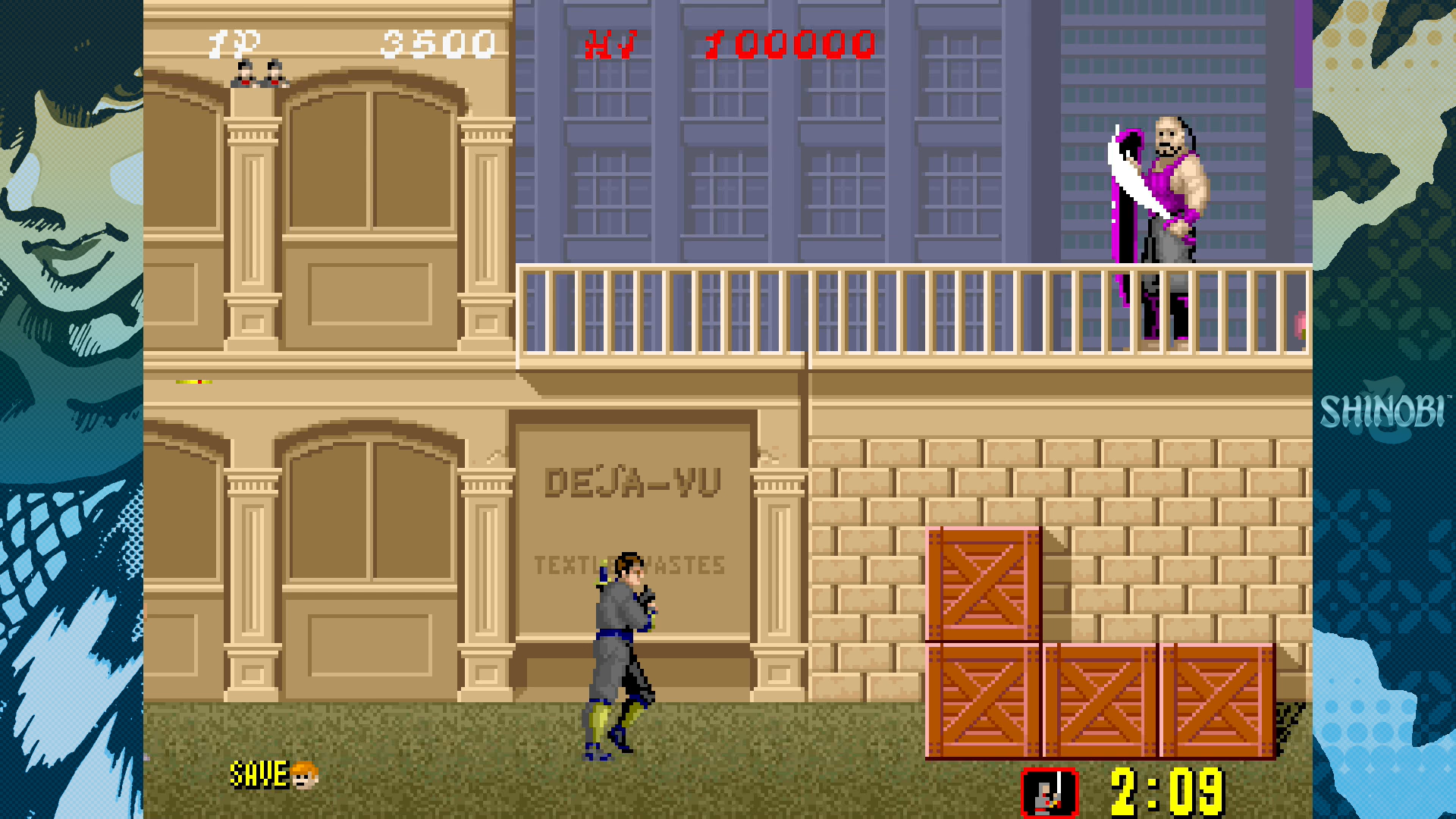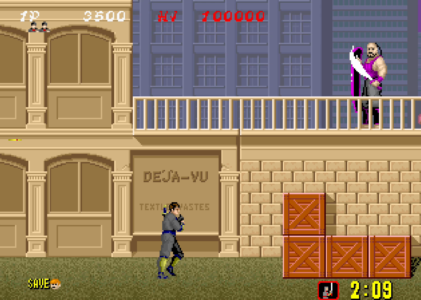Shinobi is a legendary video game that carved its name into the annals of gaming history. This action-packed adventure, developed by Sega, took the gaming world by storm with its innovative gameplay, thrilling ninja action, and challenging missions. In this in-depth exploration, we delve into the genre, platforms it was released on, gameplay mechanics, key features, strategies, cheats, reviews, cultural impact, sequels, and similar games that have been inspired by this iconic title.
The Ninja’s Playground: Genre and Platforms
Genre: Action Platformer
Shinobi, at its core, is an action platformer game that combines precise platforming with intense combat. It falls under the broader category of action-adventure games due to its emphasis on exploration and mission-based progression. This fusion of platforming and action made it a unique and engaging experience for players.

Platforms: Sega Master System, Arcade, Various Ports
Shinobi first graced the gaming scene in the arcades in 1987, showcasing its cutting-edge graphics and addictive gameplay. Later, it found its way to the Sega Master System, a popular home console of the time. Additionally, several ports were developed for different platforms, including the Nintendo Entertainment System (NES), Commodore 64, and PC. This widespread availability ensured that players from various gaming ecosystems could experience the ninja action.
The Art of the Ninja: Gameplay
Shinobi immerses players in the role of Joe Musashi, a skilled ninja on a mission to rescue kidnapped children from a group of terrorists known as “Zeed.” The gameplay is divided into different levels, each culminating in a boss battle. Here’s a breakdown of the core gameplay elements:
1. Ninja Combat:
Shinobi’s combat mechanics are both fluid and challenging. Joe Musashi is armed with an unlimited supply of shurikens (throwing stars) for ranged attacks and a katana for close combat. Precise timing and positioning are crucial to dispatch enemies effectively. The enemies range from simple foot soldiers to more formidable foes with unique attack patterns.

2. Rescue Mission:
The main objective of each level is to rescue one of the kidnapped children. These children are often held hostage by the boss of each stage. To free them, Joe must defeat the boss and ensure the child’s safe escape. This added a layer of urgency to the gameplay and gave players a clear goal in each level.
3. Ninja Magic:
Joe can also utilize powerful ninja magic, which has different effects depending on the type of magic used. These abilities, such as summoning a tornado or clearing the screen of enemies, provide a strategic advantage and are especially helpful in boss battles.
4. Platforming Challenges:
The game is not just about combat; it features intricate platforming segments that demand precision and timing. Navigating through hazardous terrain while dealing with enemies keeps players on their toes.
5. Time Limit:
A time limit adds pressure to complete each level swiftly. Running out of time results in the loss of a life, making it essential to balance speed with careful navigation and combat.
Key Gameplay Features
Shinobi’s success can be attributed to several key gameplay features that set it apart from other games of its time:
1. Ninja Realism:
Shinobi aimed for a level of realism not often seen in arcade games of the era. The character animations were fluid, and the attention to detail in the ninja’s movements added authenticity to the experience.
2. Varied Levels:
The game offered diverse environments, from urban cityscapes to ancient temples, which kept the gameplay fresh and exciting as players progressed.
3. Challenging Bosses:
Each level concluded with an epic boss battle, testing the player’s skills and reflexes. These memorable encounters added depth to the gameplay.
4. Power-Up Items:
Throughout the levels, players could find power-ups, including extra shurikens and health-restoring items. Managing these resources was crucial for success.
5. Mission Structure:
The game’s mission-based structure provided a sense of purpose and progression, motivating players to continue their quest to rescue the kidnapped children.

Strategies and Cheats: Mastering the Ninja Way
To conquer Shinobi’s challenges, players often developed strategies and even relied on cheats to gain an edge. Here are some tips and tricks that players discovered over the years:
1. Mastering Ninja Magic:
Learning when and how to use ninja magic effectively was a key strategy. Some players saved their magic for boss battles, while others used it to clear challenging sections.
2. Precision Platforming:
Perfecting the art of platforming was essential. Players had to learn the timing of jumps and attacks to navigate levels smoothly.
3. Boss Patterns:
Boss battles followed specific patterns. Understanding these patterns and learning when to attack and when to evade was crucial for success.
4. Using Power-Ups Wisely:
Managing power-up items was a skill in itself. Players had to decide when to use health-restoring items and when to save them for more challenging encounters.
5. Game Genie Cheats:
Some players resorted to Game Genie cheats, which provided various advantages like infinite lives, unlimited magic, and enhanced firepower. While these cheats made the game easier, they also changed the overall experience.
Reviews and Cultural Impact: Shinobi’s Enduring Legacy
Upon its release, Shinobi received widespread acclaim from both gamers and critics. Its challenging yet rewarding gameplay, along with its impressive graphics and animations, garnered praise. It was a standout title in the arcade and home console market, cementing Sega’s reputation as a formidable player in the gaming industry.
The cultural impact of Shinobi extended beyond the gaming world. Joe Musashi became an iconic character in the realm of video game ninjas, standing alongside the likes of Ryu Hayabusa from Ninja Gaiden and Solid Snake from Metal Gear Solid. The game’s success led to the creation of an entire franchise, including sequels, spin-offs, and adaptations.
Sequels and Spin-Offs: The Ninja Legacy Continues
Shinobi’s success paved the way for numerous sequels and spin-offs, each building upon the core gameplay while introducing new features and stories. Some notable entries in the Shinobi series include:
1. Shinobi III: Return of the Ninja Master (1993):
Often considered the pinnacle of the series, this game improved upon its predecessors in every way. It featured even more fluid animations, a wide range of ninja abilities, and memorable levels.
2. The Revenge of Shinobi (1989):
This sequel expanded on the original with enhanced graphics and more complex levels. It introduced a variety of shuriken types and featured guest appearances from pop culture icons, including Spider-Man and Batman (unofficially).
3. Shinobi (2002):
A reboot of the series, this game brought Shinobi into the 3D realm. It retained the core elements of the franchise while offering a new visual perspective and gameplay mechanics.
4. Shinobi (3DS, 2011):
This portable entry revitalized the series with 2.5D graphics and utilized the unique capabilities of the Nintendo 3DS. It received positive reviews for its challenging gameplay and updated visuals.
Similar Games: Honoring the Ninja Tradition
Shinobi’s influence can be seen in many other games that incorporate ninja themes, challenging platforming, and precise combat. Here are some examples:
1. Ninja Gaiden Series:
Like Shinobi, the Ninja Gaiden series is renowned for its challenging gameplay and agile ninja protagonist. It’s often considered one of the toughest series in gaming.
2. Strider (1989):
Strider, an action platformer, features a futuristic ninja battling against oppressive forces. It shares similarities with Shinobi in terms of fast-paced combat and intricate level design.

3. Mark of the Ninja (2012):
This indie game blends stealth and platforming, allowing players to experience the thrill of being a ninja while emphasizing stealthy takedowns and strategic play.
4. Tenchu: Stealth Assassins (1998):
Tenchu focused on stealthy ninja assassinations in feudal Japan. It provided a different perspective on ninja gameplay, emphasizing silent takedowns and evasion.
Conclusion
Shinobi remains a timeless classic in the world of video games. Its innovative gameplay, challenging missions, and iconic ninja protagonist continue to inspire gamers and game developers alike. From its arcade origins to its influence on subsequent ninja-themed titles, Shinobi’s legacy endures as a testament to the enduring appeal of ninja action and platforming.
So, whether you’re a seasoned gamer reminiscing about your ninja adventures or a newcomer eager to experience the roots of action platforming, Shinobi is a must-play title that has left an indelible mark on gaming history. Embrace your inner ninja and embark on this epic journey to rescue kidnapped children and defeat the forces of evil. The path of the ninja awaits!












